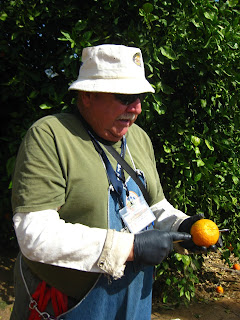We started our day with an early group hike at Lake Perris State Recreation Area.
It was basically a flat walk without too much new to see. Terry poses beside the Brittlebush in all its glory. We had bought a state park seniors' pass that was good until the end of the year.
In the visitors' centre, one of the staff was frantically looking for a brochure to give someone. It sounded interesting, so I asked her about it. "It's only 20 minutes down the road, " she said.
A volunteer docent led us through the
groves of trees, not paying too much attention
where the actual path was. He had his own favourite spots.
 He pointed to the rows of palm trees surrounding the park, and said, "They're pretty useless, and have to be trimmed continually in case a palm frond hits someone on the head." They did delineate where the roads were, though.
He pointed to the rows of palm trees surrounding the park, and said, "They're pretty useless, and have to be trimmed continually in case a palm frond hits someone on the head." They did delineate where the roads were, though. |
| Canvas sleeves protect from sharp spines |
At practically every tree, he stopped, pulled out a very sharp knife from his pouch, and cut the fruit into sections for us. There were six of us, so it wasn't too difficult. First he handed us a plastic food-type glove. After a while we could see why, as the juice dripped down our chins and all over our hands. We ate and ate to the point of satiation, so many different samples. If anyone refused a sample, he would just throw it under the trees, as we did all our peels. Not only did we eat samples, but we were also given bags in which to collect fruit to take home. We weren't allowed to pick directly off the trees until he said, "Now you can pick one," or he would do it for us.
 |
| Navel Oranges |
Did you know limes turn yellow as they ripen? But no one likes to see yellow limes!
These are called Lemonade Lemons and are variegated with these green stripes on the outside. Inside, they are faintly pink, making you think they might be sweet, but unfortunately they don't have a taste to match their description. They're pretty sour, but we had to try those, too.
This is an ancient type of citrus that candied peel is made from! I'm glad they thought of a use for it!
Then we were given another bag so we could gather our grapefruit samples. We were shown several different kinds, including a sweet light yellow variety, and the famous Rio Reds that we associate with Texas. We took a few of each, whatever could fit into the stretchy mesh bag.
Then we went to wash our sticky hands.
It was only 30 miles along the freeway to get back to Cherry Valley.
What an awesome excursion, one we hadn't even planned!














This comment has been removed by the author.
ReplyDeleteHow much for your oranges mister? Good to see you are in great form with a smile from ear to ear!
ReplyDeleteThey did not cost a thing, included with price of admission!
Delete